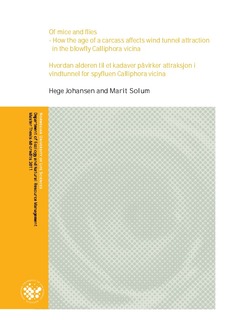| dc.description.abstract | Larvae of the saprophagous blowfly Calliphora vicina Robineau-Desvoidy (Diptera: Calliphoridae) cause substantial damage by infesting stockfish in Lofoten. A synthetic lure has been developed to control this pest, but the attraction towards this lure is still lower than
towards natural odors. Better understanding of the succession of volatiles released from a
carcass during decomposition could improve the lure by identifying missing components, or lead to the detection of antagonistic compounds. This study is a wind tunnel experiment investigating how the volatiles from carcasses of different age affects how attractive they are to male and female C. vicina. Mice carcasses
were used as natural odor sources. We predicted that flies would be more strongly attracted to carcasses in early stages of decay, and that females would show stronger preferences for early
stages than males, since they depend on the carcass for oviposition. We also performed additional experiments investigating how conspecific larval secretion affects attraction.
Both male and female C. vicina showed variation in their response to volatiles released from mice carcasses of different age, with significantly higher attraction towards carcasses that were three, six, and nine days old. We found no differences between males and females
regarding oriented flight responses, but observed an increase in landings for female flies at the most attractive carcasses. Larval secretion was not attractive when tested alone, and had little effect on attraction when added to a three day old carcass. This study shows that C. vicina is capable of assessing an odor source from a distance, without relying on visual cues provided by the source. This highlights the importance of
olfaction for blowflies when locating a resource, and indicates that they use the succession in the volatiles emitted from a carcass to locate suitable carrion. The interaction between gender and age of carcass observed for landings might point to a closer coupling of vision and olfaction in female blowflies compared to males. | en_US |
